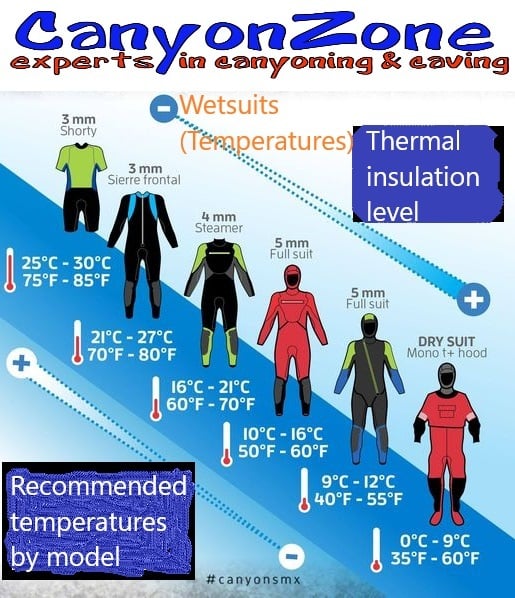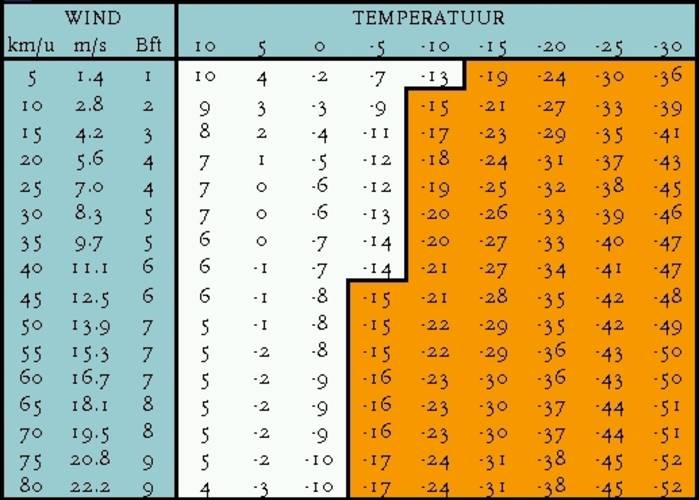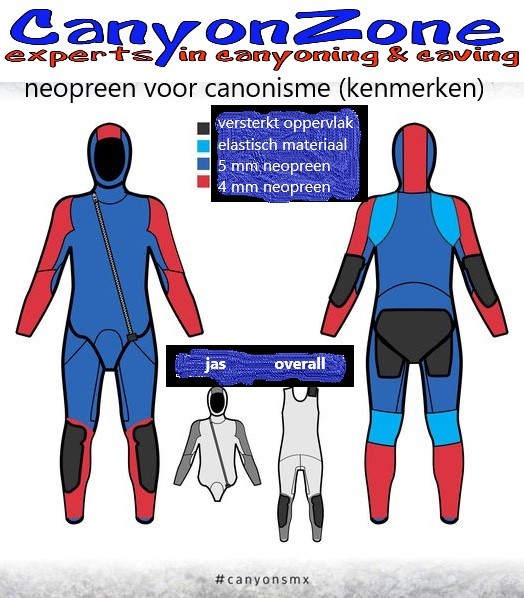How to choose a good canyoning wetsuit / canyoning suit?
A wetsuit will keep you warm during canyoning and all other water sports.
CanyonZone has indicated here what you should take into account when choosing your canyoning suit. See for the range Canyoning Neoprene clothing.
Why do we wear a wetsuit in the water?
It is important to choose a suitable wetsuit. The more heat you retain, the longer you can stay in the water and the more fun you can experience. Think of the thickness of the neoprene as a second skin that forms a protective layer against the cold water. This thickness is indicated by two or three numbers: 5/4 millimeters, 4/3 or 3/2 millimeters (the first number represents the thickness of the suit on the legs and the second number represents the thickness of the arms). A 2/2 millimeter wetsuit is not warm enough to wear in autumn and winter
When you go into the water, water enters your wetsuit and your suit ensures that you stay warm because a thin layer of water remains between your skin and the neoprene. Very handy because the water warms you up with your own body heat. The ideal wetsuit for autumn: the 3/2 millimeter. These wetsuits are less thick at the arms so you can move more easily. At temperatures below 17°C, choose the 4/3 millimeter. In general, the thicker the neoprene of your wetsuit, the warmer it keeps you. The wetsuit 5/4 mm is the best protection against very cold water.
Note: Sometimes you will find 5/4/3mm wetsuits (which is the case with our women's model). This is a combination between a 4/3 mm and a 5/4 mm wetsuit.
If water flows through it, it won't stay warm, but it's fine if something flows through it. Wetsuits are designed to let water in and then retain that water, which warms up your body and thus keeps you warm. Dry suits or dry suits keep you warm and dry, wetsuits keep you warm and wet
In addition, the neoprene that is in your wetsuit ensures the insulation of your body.
Is your wetsuit too roomy? Then there is always (cold) water in your wetsuit.
Wetsuits are available in the following thicknesses:
- 2/1mm
- 3/2 mm
- 4/3mm
- 5/3mm and 5/4mm
A 4/3 wetsuit, for example, is made of 4mm and 3mm thick neoprene. The suit is then 4 millimeters thick on the chest and 3 mm thick at the legs.
Water temperature is the deciding factor when choosing a wetsuit

The table shows the appropriate thickness for each water temperature.
However, the Feeling Temperature (wind chill factor) is also just as important. The longer your body will be above the water, the more important the windchill factor becomes.
| WATER TEMPERATURE | WETSUIT THICKNESS | |
|---|---|---|
| BELOW 3° | VERY COLD | WETSUIT BETWEEN |
| BETWEEN 4-7° | VERY COLD | WETSUIT BETWEEN |
| BETWEEN 8-11° | COLD | WETSUIT BETWEEN 4/3MM AND 5/4MM |
| BETWEEN 12-17° | COOL | WETSUIT BETWEEN 3/2MM AND 4/3MM |
| BETWEEN 18-20° | WARM | WETSUIT OF 2MM |
| Between 21-25° | NICE WARM | WETSUIT OF 1MM |
| BOVEN DE 26° | TROPICAL | WETSUIT WITH UV PROTECTION FROM LYCRA (UV LYCRA) |
Feeling temperature (wind chill)
In the wind it can feel a lot colder than out of the wind.
We express heat loss in an emotional value of the temperature: the perceived temperature. The difference between the measured air temperature and the perceived temperature is a measure of extra heat loss.
Table for determining the perceived temperature according to the JAG/TI method used by the KNMI ©KNMI

Material Neoprene
 Wetsuits are generally made of neoprene. Neoprene is the flexible rubber. A kind of foam, made from petroleum. In difficult terms, neoprene or polychloroprene is an elastomer or synthetic rubber obtained by the polymerization of chloroprene. The mini bubbles in neoprene provide the insulation of your body.
Wetsuits are generally made of neoprene. Neoprene is the flexible rubber. A kind of foam, made from petroleum. In difficult terms, neoprene or polychloroprene is an elastomer or synthetic rubber obtained by the polymerization of chloroprene. The mini bubbles in neoprene provide the insulation of your body.
The degree of elasticity and insulation make up the difference in the prices of wetsuits. The quality of neoprene can therefore differ greatly and cause large price differences. Neoprene is made from petroleum and widely varying in quality, an elastic synthetic rubber material that has good insulation properties.
What do you actually wear under a wetsuit?
In other words, are you naked under a wetsuit? It is not described anywhere but most people don't wear anything under their wetsuit.
OK, if you're renting a wetsuit and you don't like the idea of your private parts rubbing where others have rubbed, wear a bathing suit or tight-fitting swimsuit under the wetsuit. There is limited chafing and the wetsuit feels like a second skin.
Swimwear for women is perfect for under wetsuits. They are supportive and eliminate friction.
Depending on your suit and the temperature, a neoprene shirt/shirt is recommended.
Can water get into my wetsuit?
Wetsuits are designed to let water in and then retain that water, which warms up your body and thus keeps you warm. Dry suits or dry suits keep you warm and dry, wet suits keep you warm and wet.
Overview Canyoning knowledge base: Go back.
CanyonZone
-
- Experts in canyoning & caving gear - ship worldwide
-
- Rent outdoor equipment
- New items in assortment
- Special offers
- Pre-ordering 2025
- NEW - Petzl Canyoning / Caving Line 2025
- 2nd hand canyoning caving articles
- Items / packages customer specific
- Giftcards of CanyonZone
-
- Canyoning (basic) equipment
- Canyoning equipment packages
- Luggage / Travel Bags
-
Canyoning Neoprene clothing
- Size charts by Brand
- Aventure Verticale (AV) size charts
- CE4Y neoprene size charts
- GUARA neoprene size charts
- Seland neoprene clothing size charts
- Newex neoprene size charts
- NRS neoprene size charts
- Vade Retro neoprene size charts
- Custom made neoprene wetsuit, required size data
- Canyoning Wetsuits
- Protective Canyoning Clothing
- Canyoning Neoprene Headgear
- Canyoning Drysuit / Undersuit
- Canyoning Neoprene shirts & shorts
- Canyoning Knee - elbow protectors / pads
- Canyoning Neoprene gloves
- Canyoning Neoprene socks
- Canyoning shoes
- Harnesses & Accessories
- Helmets outdoor sports
- Carabiners & maillons
- Descend devices
- Ascending / Rise along rope
- Pulleys
- Rope & webbing slings
- Anchoring & accessories
- Via Ferrata / Klettersteig sets
- Outdoor Gloves / (ice-)canyoning, caving, via ferrata
- Canyoning Back Packs, bags & duffels
- Drybags & Kegs, Boats
- Outdoor Knives & Scissors
- Safety in outdoor sports
- First Aid / Medical Articles
- Rescue in outdoor sports
- Camping, Bivouac & Backpacking
- Winter- / Ice Canyoning
-
Canyoning Books & Topographic Maps
- Map Pouch
-
Canyoning Guide Books
- Australia
- Austria
- France (including Corsica and La Reunion)
- Germany
- Greece (including Crete) / Balkans
- Israel
- Italy (including Sardinia)
- Jordan / Middle East
- Morocco
- New Zealand & Australia
- Portugal (including Madeira and Azores)
- Scandinavia
- Slovenia
- Spain (including Canary Islands and Majorca)
- United Kingdom (UK) / Scotland
- United States of America
- South America
- Switzerland
- Turkey
- Canyoning Techniques & Skills
- Canyoning Maps
- Outdoor Children's Books
- Outdoor DVDs
- Via Ferrata / Klettersteig books
- Repair & Maintenance
- Miscellaneous items outdoor sports
-
- Especially for Ladies
- Especially for Children
- Especially for Instructors and Guides
- Especially for Outdoor Sports Companies
- Especially for Underwater / Cave diving / Diving
-
- Caving (basic) equipment
- Caving equipments packages
- Caving Suits / Overalls
- Caving Under Suits
- Caving Boots / Wellies
- Caving Socks
- Caving Knee- and Elbow Pads
- Caving Gloves
- Headlamps & torches
- Caving Bags & BackPacks
- Tents and Bivi bags
- Caving & Potholing Books
-
-
Climbing related gear: on request
-
- Services
-
- CanyonZone New(s)
- CanyonZone Customer Service
- Contact about Assortment
- Business ordering at CanyonZone
- About CanyonZone
- CanyonZone's FAQ
- CanyonZone's Knowledge Base
- About CanyonZone, owner Gertjan van Pelt
- Works together with
- Link exchange
-
- Privacy
- Terms and Conditions
-
Terms and Conditions Rental
-


